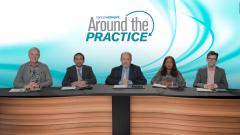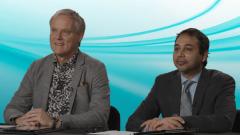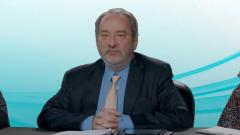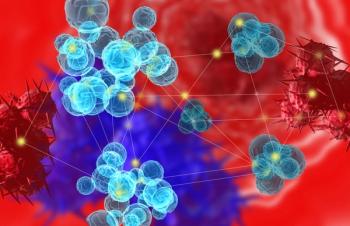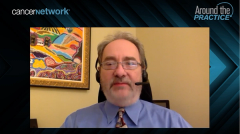
DETERMINATION, GRIFFIN, and MASTER Studies
Expert panelists discuss recent data updates from the DETERMINATION, GRIFFIN, and MASTER studies.
Episodes in this series

Transcript:
Robert Z. Orlowski, MD: Let’s start with Dr Landgren. Ola, give us an update on the results of the DETERMINATION study, which were presented and published this year, and are an important update.
C. Ola Landgren, MD: Yes. The DETERMINATION study is an important study. It was published in the New England Journal of Medicine this fall. It was also at the plenary presentations at the ASCO [American Society of Clinical Oncology] meeting in Chicago in June. The study usesthe traditional backbone of RVd [lenalidomide, bortezomib, dexamethasone]. There were 2 arms; patients were either randomized to 8 cycles of RVd therapy, or 5 cycles of RVd therapy, including a bone marrow transplant. Those patients who received the 8 cycles, they underwent collection of stem cells. After patients had received these 8 cycles or 5 cycles with a transplant, they went to continuous lenalidomide maintenance, with 10 mg as a single therapy. This was continuous. The primary end point of the study was progression-free survival [PFS], and the study showed that transplant adds significantly longer PFS, it was 21 months. So, the study was successful in favor of transplant. Also, the study showed that overall survival at 6 years of follow-up was the same for the 2 arms. They also stratified the results by MRD [minimal residual disease] in a subanalysis, and they showed that if you achieve MRD negativity with or without transplant, there were more patients being MRD negative with transplant. But if you were MRD negative on either of the 2 arms, the PFS was the same. This addresses a lot of questions. How are we going to treat patients in the future? What’s the right approach, should we monitor for MRD? This is not yet established. This is an area of controversy.
Robert Z. Orlowski, MD: Moving from a 3-drug regimen to a 4-drug regimen, Amrita, could you give us an update on the latest results from the GRIFFIN study and a quick overview of the trial as well for those people at home who may not know it in detail?
Amrita Krishnan, MD: Yes. GRIFFIN, I view as a practice-changing trial now. It’s a phase 2 trial, but it was randomized between RVd induction, similar to what was used in DETERMINATION, and daratumumab plus RVd induction, both arms getting a transplant, which is an important point as well. Then consolidation either with daratumumab-RVd or RVd. Then again, the daratumumab arm continued with daratumumab maintenance for 2 years plus lenalidomide maintenance, and the other arm was lenalidomide maintenance. Updated data now show a progression-free survival advantage for the daratumumab arm. That’s an important point because we were all waiting for that. There’s also a much higher rate of MRD negativity, over 90%, by the time you finish all phases of the trial. It shows for us now that intensifying induction and with a consolidative transplant strategy followed by a daratumumab-based strategy post-transplant can induce deep responses. We want to see overall survival benefits in high-risk patients as well. There seems to be a trend to that, though it certainly can’t make it standard risk, but it can also help improve outcomes.
Robert Z. Orlowski, MD: You mentioned there was maintenance with either lenalidomide or lenalidomide and daratumumab on this study. What do you think about adding daratumumab to maintenance? And maybe this is an opportunity for a shameless plug for your SWOG study that you’re leading.
Amrita Krishnan, MD: You read my mind, Bob. The CASSIOPEIA trial, which was daratumumab-VTd [bortezomib, thalidomide, dexamethasone] vs VTd followed by daratumumab or observation, showed some benefit to daratumumab-based maintenance, but it raised some questions. With the SWOG trial, which is much more of a real-world scenario because it doesn’t mandate induction, everyone gets transplants, and then you get randomized to daratumumab and lenalidomide, or lenalidomide alone for 2 years, MRD assessed, and then a second randomization to either continuing or stopping maintenance.It will answer a question in a randomized fashion, is adding daratumumab post-transplant going to improve our depth of response? And the trial is powered for overall survival, so at the end of the day, that’s what we all want to know.
Robert Z. Orlowski, MD: Very good. Now Ajay, Amrita mentioned high-risk patients. Can you tell us a bit about the MASTER study, which did have a particular focus on high risk, although other patients were included as well?
Ajay K. Nooka, MD: Yes. Contrary to the 2 studies, DETERMINATION and GRIFFIN that you heard, MASTER is a single-arm study. It asks 2 specific questions, what’s the impact of using this quadruple regimen, carfilzomib, daratumumab, lenalidomide, and dexamethasone? It also asks the most important question we are all looking for, can we use any surrogates to stop treatment? The way the trial was designed was unique and innovative. Patients would receive 4 cycles of daratumumab plus KRd [carfilzomib, lenalidomide, dexamethasone]. These cycles are given as boxes. And after each of these 4 cycles, patients would get their MRD negativity testing done. If the patients achieved consistent MRD negativity, they’re able to stop the treatment. A very innovative design. I’ll talk about what is the impact of the induction therapy with daratumumab plus KRd? After the first 4 cycles, patients achieved a beautiful response. Even the high-risk patients were able to see MRD negativity rates that are reaching almost 60% at 10-6. These are unprecedented rates for some people with high-risk disease.
What we saw with longer follow-up was this strategy of how we are able to stop maintenance works for a group of patients, but may not be applicable across the group. There are 3 groups of patients who were isolated from this study. One was the patients who have standard-risk disease. The second group is patients who have 1 high-risk cytogenetic abnormality. The third group is the ones who have more than 2 high-risk cytogenic abnormalities. What we saw was that even though this regimen was able to get to the depth of response we were all anticipating, stopping the treatment may not be applicable for these patients with more high-risk cytogenic abnormalities. As we saw, by the 2-year mark, 50% of these patients were relapsing. The take-home message from me is identifying those subsets that could benefit more from an approach like this would be applicable, and those patients with high-risk cytogenetics can use these daratumumab plus KRd regimens, but stopping treatment may not be applicable in those patients.
Amrita Krishnan, MD: If I may, Bob, can I put Ola on the spot? Because we saw the same patient for a consult of newly diagnosed and what to treat with for induction. I said daratumumab-RVd, and Ola said something different, he said daratumumab-KRd.I’d be curious to know how you make a distinction in that choice?
C. Ola Landgren, MD: It’s reflective of many things. One thing is there are so many treatment options, and it’s reflective of the fact that we are all experts and we are moving the field forward. And in the absence of a randomized study showing that one is the winner over the other, we should pursue those approaches, working with what we believe in, what we see in our practices. So, we build up data. But eventually, it would be great to have a randomized study. The reason I would favor the daratumumab-KRd is because I worked on it for a long time, and I did develop the MANHATTAN trial that was published in 2021, where we gave 8 cycles of daratumumab-KRd and we found 71% MRD negativity, which is a very good result. Patients were allowed to keep their collected stem cells or go to a transplant, and we let patients and doctors decide. About half the patients went to transplant, half of them didn’t. We continue to follow, and at 3 years of follow-up, so far there is no difference. But that’s not part of the primary end point. The primary end point was to determine MRD at 8 cycle. That was my bias, but the field will move on. There will be other options. Isn’t that how it goes?
Transcript edited for clarity.
Newsletter
Stay up to date on recent advances in the multidisciplinary approach to cancer.


